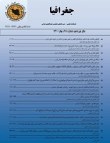Prioritization of Earthquake Risk in Areas Affected by Sarpol-e-Zahab Earthquake Using Electere Model
The Sarpol-e-Zahab earthquake with a magnitude of 7.3 occurred at 21:48 local time on November 12, 2017 near the city of Ozgeleh-e-Sarpol-e-Zahab in Kermanshah province in northwestern Iran. The earthquake destroyed large parts of the city of Sarpol-e Zahab and many surrounding towns and villages. The magnitude of the earthquake was so great that it was felt up to hundreds of kilometers from the epicenter (even in Tehran). The region affected by the Sarpol-e Zahab earthquake is very prone to the occurrence of various geological and geotechnical instabilities such as landslides and rock falls. The reasons for this talent are the existence of young folds in the Zagros Mountains along with the operation of the faults that cut these mountains, which have caused severe fractures in the region. On the other hand, the sequence of hard and loose layers of geological formations has predisposed many of these areas to slip hard layers on the loose lower layers due to the loss of the heel of the slopes, due to river leaching and construction operations. Also, rich groundwater resources in the mountains of the region have increased the potential for slope instabilities. Another important aspect of earthquake research is the study of factors affecting earthquakes, such as the type of materials that make up the earth's bed, the impact of geological structures such as faults and fractures, and slopes. . . Are. Another aspect of research is to study the geological and geomorphological consequences of earthquakes such as Landslides, Rockslides, Landslides and Rises, etc. in order to manage the crisis and assess the damage caused by them. Therefore, the main issue in this study is the exposure of the study area to two main issues, namely the damage caused by the earthquake itself and the other effects, phenomena and geomorphological evidence that came after the main earthquake. Therefore, accurate identification of areas in terms of seismicity and potential for seismicity is necessary in order to manage and plan it. The main purpose of this study, taking into account the results of this research and also the characteristics affecting the occurrence of earthquake, in the study area, the ELECTERE technique has been used to prioritize different areas covered by the Sarpol-e-Zahab earthquake. Therefore, by using multi-criteria decision-making techniques, it is possible to consider various quantitative and qualitative criteria and use the results of expert opinions in weighting the criteria, in which case the final decision will be more consistent with the real conditions in nature.
In order to monitor and study the geomorphological phenomena related to the Ozgeleh earthquake from the herd, visits were made in several stages of the affected areas. Also, some available documents and published reports and media sources were reviewed during this period. Due to the nature of the subject, the research method is citation, experimental and field observations and descriptive-analytical. The required data were collected in a library manner. Methods of data collection in this research include library study, collection of reports published by the Seismological Research Institute affiliated to the International Institute of Seismology and Earthquake Engineering, observations and field visits. According to the objectives of the study, the effective factors in geomorphological instabilities including lithological age, distance from the fault, slope, altitude, precipitation, distance from the river, distance from the road and land use were selected. To prepare geological age layers and distance from faults from geological maps prepared by the Geological Survey of Iran, from topographic map to prepare slope layers, distance from road, distance from river and altitude, to prepare climate map from statistics Precipitation of synoptic stations, for the preparation of soil layers and land use, the land use map prepared by the Forests and Rangelands Organization has been used. All 9 layers were prepared in GIS environment.
In this study, geomorphological instabilities resulting from Ozgeleh earthquakes in Kermanshah and Ilam were analyzed using the multi-characteristic ELECTERE decision method. The region affected by this earthquake has a high potential for the occurrence of various movements and geomorphological and amplitude instabilities. The first step in this research is to identify various forms of instability such as landslides, rock falls and avalanches, currents, ruptures of hills and landslides that lead to road blockages, destruction of residential houses and ... In the second stage, the identification of various factors affecting the intensification of instabilities includes lithological age, distance from the fault, slope, altitude, precipitation, distance from the river, distance from the road and land use. Finally, the implementation of the area prioritization model is based on the ELECTERE model.
The results showed that among the factors affecting the occurrence of instabilities, geological age factors, distance from faults and slopes have the most impact and soil and land use factors have the least impact on creating instabilities in the region. Considering the prioritization of regions in terms of seismic potential that was extracted from the ELECTERE model, Sarpol-e-Zahab region with the highest seismic potential, which is located in the relative seismic hazard classification in the hazard class, has the first priority. The reason for the high seismic risk of this region is the geological structure of the region, its proximity to the main Zagros fault. Also, Dalahou and Javanroud regions are in the second priority by being in the high risk category. The main reason for its seismic potential is the geological structure and frequency of faults and its location on the Zagros fault. In order to validate the model used in the study area, instabilities including landslides, rock falls and avalanches, liquefaction, rupture of hills, flow and mud materials were adapted to each of the danger zones. The results of this adaptation showed that out of 38 known geomorphological instabilities in the region, 18 were in the very high risk category, 11 were in the high risk category, 6 were in the medium risk category and 3 were in the low risk category. have taken. The results of validation of geomorphological instabilities with the zoning map of relative earthquake risk and also compliance with study areas (7 areas) indicate the relatively good performance of the ELECTERE model in zoning and prioritization of areas in study areas. Using this method with similar areas can provide acceptable results.
Prioritization , Earthquake , Sarpolzahab , model , Electra
- حق عضویت دریافتی صرف حمایت از نشریات عضو و نگهداری، تکمیل و توسعه مگیران میشود.
- پرداخت حق اشتراک و دانلود مقالات اجازه بازنشر آن در سایر رسانههای چاپی و دیجیتال را به کاربر نمیدهد.




